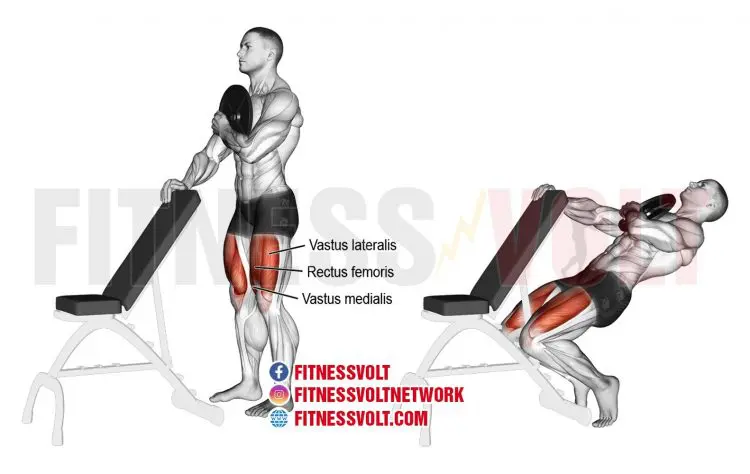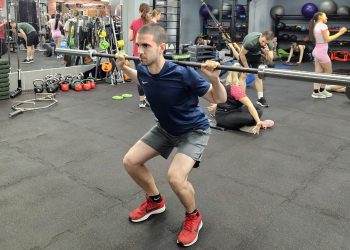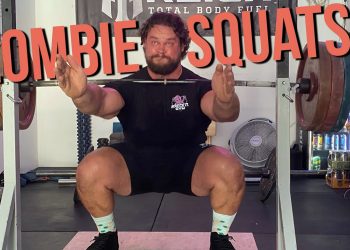I’ll admit, in my 30-odd years of working as a personal trainer, I’ve never gotten used to the name “sissy squat.” I mean, who wants to do an exercise with the name “sissy” in it?
However, the reality is that this exercise is anything but a ‘sissy’ move. In fact, it’s one of the most challenging quads exercises I know. My clients and I have a love/hate relationship with sissy squats. We love how effective it is, but hate how hard it feels Even light loads seem to weigh a ton!
The sissy squat has been around for a long time. The name actually comes from King Sisyphus of Greek mythology. It was popularized in the ’60s by an eccentric trainer who was way ahead of his time by the name of Vince Gironda.
The common belief that Vince banned the barbell squat from his gym in favor of the sissy squat can’t be verified.
That said, there is no doubt that he favored the sissy squat over the traditional version. He was convinced that it better isolated the quads and deloaded the lower back. My long experience in the fitness industry supports this point of view.
In this article, I’m going to tell you all about the sissy squat, from how to perform it correctly to the benefits to alternatives you can do instead.
Level Up Your Fitness: Join our 💪 strong community in Fitness Volt Newsletter. Get daily inspiration, expert-backed workouts, nutrition tips, the latest in strength sports, and the support you need to reach your goals. Subscribe for free!
What is the Sissy Squat?
The Sissy Squat is a squat variation that can be done with or without added resistance. This type of squat has two key differences:
- Your hips remain locked so that the upper body forms a straight line with the upper leg (femur).
- Your lower leg (tibia) achieves a near perpendicular angle, placing maximum activation on your quadriceps.
To do the exercise properly, you need to lean back as much as you can. This makes maintaining your balance a challenge. As a result, you should hold onto a support for balance or hold onto a counterweight such as a cable or resistance band.

Sissy Squat Benefits
Vince Gironda was right on with his championing of this exercise. Here are the main benefits of doing the sissy squat:
- Quadriceps activation: The tibia is the operation lever for the quadriceps. The greater its angle, the more active the quads become. The sissy squat allows you to achieve a more perpendicular lower leg (tibia) angle than virtually any other exercise. That results in greater quad activation.
- No spinal compression: With the sissy squat, there is no loading of the spine. Compare that to the barbell squat, which places a large compressive force on your spinal discs.
- Equipment free: The sissy squat can be done with absolutely no equipment. When done properly, this exercise is challenging with just your body weight. When you’re ready for extra resistance, there are a number of ways to do it.
- Lower Body Muscle Activation: In addition to the quads, the sissy squat also works the glutes, hamstrings, and calves.
- Core Stability: The bodyweight sissy squat challenges your body stability, helping to balance and strengthen your core.
Exercise Instructions
Because of its ability to isolate the quads, the sissy squat is a difficult exercise. Before advancing to the weighted version of the sissy squat, you should perfect your form and build up your strength with the body weight version.
Here’s how to do it:
- Stand in front of something stable (such as a power rack) and hold onto it with one hand for balance. Position your feet at a slightly wider than shoulder-width distance apart.
- Lean back as you transfer your weight to the balls of your feet, maintaining a tight core
- Lean back as far as you can, keeping your abs tight and keeping a straight line from your head to your knees.
- Bend your knees to descend to the floor, allowing your knees to track over your toes. Go down as low as you can. Your heels will come off the floor in the bottom position.
- Push through the balls of your feet to return to a standing position.
The Weighted Sissy Squat
When you’re ready to advance to the weighted version of the sissy squat, there are a few ways to do it:
- Hold a weight plate
- Wear a weighted backpack
- Use a resistance band to create tension
- Use a cable machine
- Repeat for the desired number of reps.
My personal favorite is the cable machine. The counterweight of the machine allows you to lean back more without toppling over. A cable machine also allows you to increase your weight easily.
You may not have access to a cable machine if you’re working out at home. Even at the gym, accessing the few cable machines can be a real problem. That’s where the weight plate version of the sissy squat becomes useful.
Weight Plate Sissy Squat
- Stand in front of a secure upright like a power rack frame, grabbing it with one hand for balance. Place your feet slightly wider than shoulder-width apart.
- Hold a weight plate in your free arm across your chest.
- Now, squat down past parallel but lean your torso back and bring your knees over your feet so you’re on the balls of your feet. Inhale during this portion of the exercise.
- Then, squat back up through the balls of your feet until you’re standing straight. Exhale during this portion of the exercise.
- Repeat for the desired number of reps.
Weighted Backpack
- Load a backpack with the desired amount of weight plates. Then put the backpack on backwards so that the weights are over your chest.
- Stand in front of a secure upright, such as a power rack, with your feet a little wider than shoulder-width apart.
- Grab onto the upright for support and lean back as far as you can. Ideally, your body should form a straight line from your neck to your knees.
- Squat down to parallel or slightly lower.
- Push through the balls of your feet to return to the start position.
- Repeat for the desired number of reps.
Band Tension Sissy Squat
Band tension will allow you to lean back more as the band resistance acts as a counterweight. The more you lean back, the greater quad activation you will achieve.
- Secure a resistance band to a high anchor point, such as the top of a door or the cross beam of a power rack frame.
- Stand about three feet in front of the anchor point, facing it. Your feet should be slightly wider than shoulder-width apart.
- Grab hold of the resistance band handles with an overhand grip. Adjust your position so that your arms are fully extended, and lean back as much as you can.
- Bend your knees to lower into a parallel squat position or slightly lower. In the bottom position, your lower legs should be nearly perpendicular.
- Push through the balls of your feet to return to the start position.
- Repeat for the desired number of reps.
Cable Machine Sissy Squat
- Set the pulleys on a double weight stack cable machine at their lowest settings.
- Stand about three feet away from the machine, facing it. I recommend using a slant board or other elevated platform to raise your heels. This will direct more effort toward your quads. Your palms should be facing inward as you hold the cable handles put in front of you.
- Lean back as far as you can as you descend until your quads are parallel to the floor. In the bottom position, your lower legs should be near perpendicular
- Pause briefly in the bottom position before pushing through the balls of your feet to return to the start position.
- Repeat for the desired number of reps.
Pro-Trainer Tips:
- You can use only your body weight if you’re a beginner.
- Make sure to lean your torso back safely and squat so your knees pass your feet.
- You should be squatting with the balls of your feet rather than with your heels.
- You should feel the sissy squat in your quads.
- Elevate your heels by standing on a slant board to ensure lack of ankle mobility doesn’t impede your range of movement.
- The sissy squat is a great squat alternative that creates more resistance than a standard bodyweight squat.
How to Program the Sissy Squat
The sissy squat can either be used as an alternative to traditional squats or in addition to them.
Level Up Your Fitness: Join our 💪 strong community in Fitness Volt Newsletter. Get daily inspiration, expert-backed workouts, nutrition tips, the latest in strength sports, and the support you need to reach your goals. Subscribe for free!
If you are purely interested in quadriceps size and strength,
I believe you will get more bang for your buck by doing sissy squats and leg extensions for a total of 10-12 sets per workout.
Here is a rep and set scheme that my personal training clients have been finding success with:
Cable Sissy Squats
- 1st Set: 30 reps
- 2nd Set: 20 reps
- 3rd Set: 15 reps
- 4th Set: 10 reps
- 5th Set: 8 reps
- 6th Set: 6 reps
Leg Extensions
- 1st Set: 30 reps
- 2nd Set: 20 reps
- 3rd Set: 15 reps
- 4th Set: 10 reps
- 5th Set: 8 reps
- 6th Set: 6 reps
If your training goal is more general lower body (including glutes and hamstrings) and strength development, and you can handle the spinal compression, add sissy squats after barbell squats. This will deliver an awesome burnout pump to your quads.
Is the Sissy Squat Bad for Your Knees?
The sissy squat fell out of favor in the 80s. This was largely due to the belief that any exercise that took your knees over your toes was bad for you. The common complaint was that it would lead to knee shearing. That belief was blown out of the water with the rise of Ben Patrick, aka Knees Over Toes Guy.
Ben has proven through his own example and research that extending your knees over your toes strengthens your ligaments and your knees. Science backs him up.
A 2013 meta-study published in the journal Sports Medicine found that when performed with proper technique and under expert supervision, deep squats can be an effective exercise for lower extremity strengthening and injury prevention without an increased risk of injury to passive tissues. [1]
Another study, this one from 1990, looked at the strength improvements from different ranges of motion on the leg extension machine. From the results, we can draw conclusions about the effectiveness of the full range of motion you can achieve with the sissy squat, which is even greater than the leg extension.
The study involved three groups, each one performing a different leg extension range of motion:
- 1st Group: Bottom half of the range of motion
- 2nd Group: Top half of the range of motion
- 3rd Group: Full range of motion
Only group three achieved strength through the full range of motion. This shows that a greater range of motion results in greater strength development. [2]
Should You Use a Sissy Squat Bench?
A sissy squat bench is a device that locks your feet in place as you perform a bodyweight squat. This locked-in position prevents your lower leg from moving. Most people perform the sissy squat on the sissy squat on a bench with their upper body upright or slightly leaning forward.
As we’ve already seen, the greatest benefit comes when you perform the sissy squat with your upper body leaning back and your lower leg being as close to perpendicular as possible. Neither of these things happens when you do the exercise on a sissy squat bench.
As a result, I do not recommend doing the sissy squat with a bench.
Conclusion
The sissy squat is one of the most effective quadricep isolating exercises that exist. Contrary to its name, it is also one of the most difficult when done correctly. Take your time to learn how to do the exercise properly, focusing on leaning back and achieving the maximum level of lower leg bend.
Once you can do three sets of 12 reps with your body weight, use one of the methods described to add weight. If you have access to one, use a cable machine for the best results. Combine sissy squats with leg extensions for the ultimate one-two quad assault.
References
- Hartmann H, Wirth K, Klusemann M. Analysis of the load on the knee joint and vertebral column with changes in squatting depth and weight load. Sports Med. 2013 Oct;43(10):993-1008. doi: 10.1007/s40279-013-0073-6. PMID: 23821469.
- Baye, J. (2013). Constant vs. Variable Resistance Training. Retrieved from https://baye.com/wp-content/uploads/2013/02/Constant-vs-Variable-Resistance.pdf
Interested in measuring your progress? Check out our strength standards for Bodyweight Squat, Sissy Squat, Leg Extension, and more.











